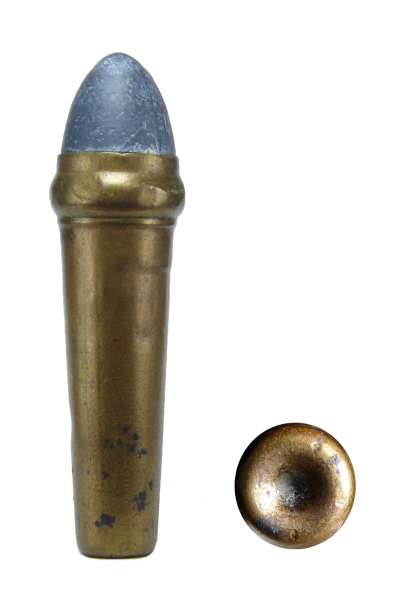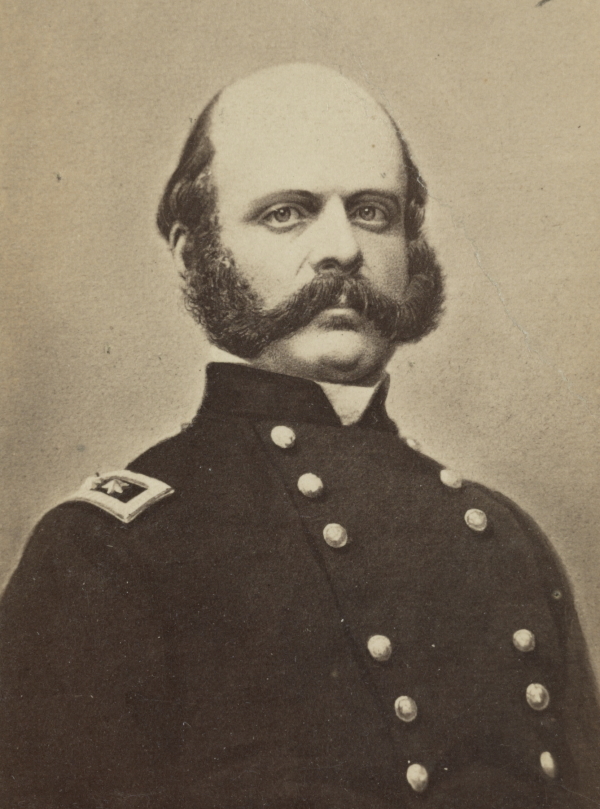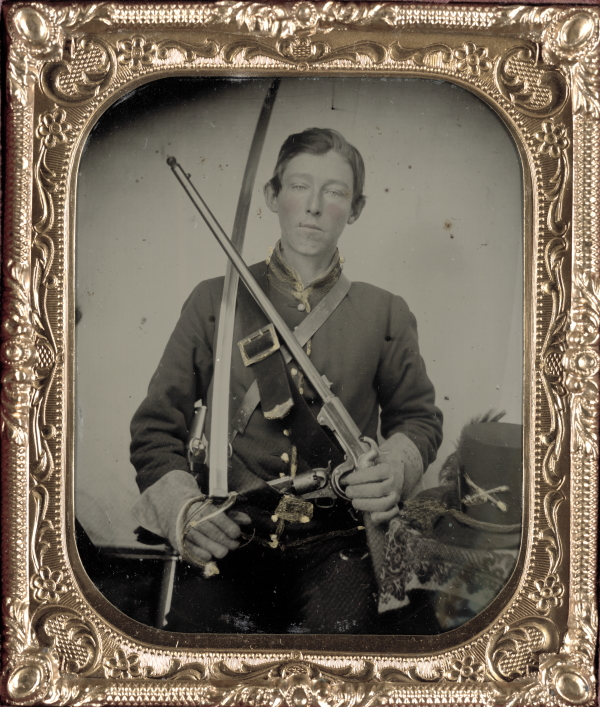
Find out about the Burnside Carbine on display by clicking/pressing the play button. Scroll down to view the images. At the bottom of the page is a YouTube video about loading and firing the Burnside carbine. You can follow along with the audio's script at the end of the page.

Burnside Carbine (Wikimedia Commons)

Burnside Cartridges (Wikimedia Commons)

Maj. Gen. Ambrose Burnside (Library of Congress)

Unidentified soldier in Union uniform with Burnside carbine, revolver, and sword (Library of Congress)
This is a 10-minute YouTube video (produced by Valmont Firearms) of someone discussing the Burnside carbine.
>
The Burnside Carbine on display was donated to the museum by Dr. John H. Spencer of Fort Scott, Kansas. It was used during the Battle of Westport.
The Burnside Carbine was invented by Ambrose E. Burnside. Maj. Gen. Ambrose Burnside, you may recall, was in command of the Union Army of the Potomac when it was defeated at the Battle of Fredericksburg, Virginia. Burnside was a West Point graduate who had resigned his commission in 1853 to command his home state Rhode Island militia. This is when Burnside started focusing on designing a better carbine. He invented the carbine in the 1850s.
The Burnside carbine (US Patent 14,491) was a single shot, breech-loading carbine. It was third most popular carbine with Civil War cavalrymen. Only the Spencer and Sharps Carbines were more popular. During the Civil War, 55,567 Burnside carbines were purchased by the US War Department for $25.42 and a box of 100 cartridges cost $2.51.
The carbine was loaded by using the trigger guards to open the breech lock. Then a copper cartridge specially designed by Burnside was inserted into the breech. The copper cartridge contained black powder and a lead bullet. A standard percussion cap had to be placed on the nipple before firing the gun. The hammer hit the percussion cap causing a fire which ignited the black powder through a small hole in the base of the cartridge.
Burnside’s design solved a long-standing problem with breech-loading rifles. When fired, breech-loading rifles often leaked hot gases which burned whoever fired the rifle. It was the specially designed shape of the cartridge that sealed the joint between the barrel and the breech, thus preventing the hot gases from escaping.
In 1858–59, the US Army tested the Burnside Carbine at the Washington Navy Yard during which 500 rounds were fired without any malfunction. But 30 of 470 aimed shots missed and 8-foot square target at 500 yards. So, the US Army declined to place an order for the carbines even though they called it the “best imperfect system” tested. Without the US Army as a customer, Burnside’s Bristol Firearms Company went out of business. A new company, the Burnside Rifle Company, was formed and its chief mechanic, George P. Foster, made improvements to the firearm’s design and a new US Patent (27,874) was obtained. When the Civil War began, several thousand of the new Burnside Carbines were ordered for Union cavalrymen. But even the new design had a flaw. After opening the breech, it was difficult to remove the expended cartridge and then insert a fresh cartridge. Now Isaac Hartshorn redesigned the carbine’s breech and solved the problem (US Patent 38,042). Then a new design flaw was discovered; the cartridge sometimes jammed when closing the breech. Another employee, George Bacon (US Patent 39,270), corrected this flaw in July 1863.
At the end of the war, production of the Burnside carbine ceased. A total of over 70,000 carbines had been produced over the last four years. But, in the end, it was the cartridge that was the carbine’s downfall. Without a supply of these cartridges, the Burnside carbine was useless. The Spencer rimfire cartridge became a standard for rifle cartridges and the Burnside carbine fell out of favor.
Written and produced by Dick Titterington, aka theCivilWarMuse.